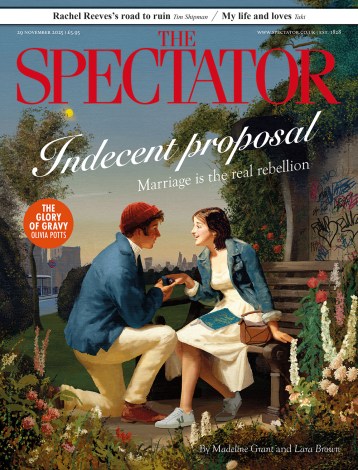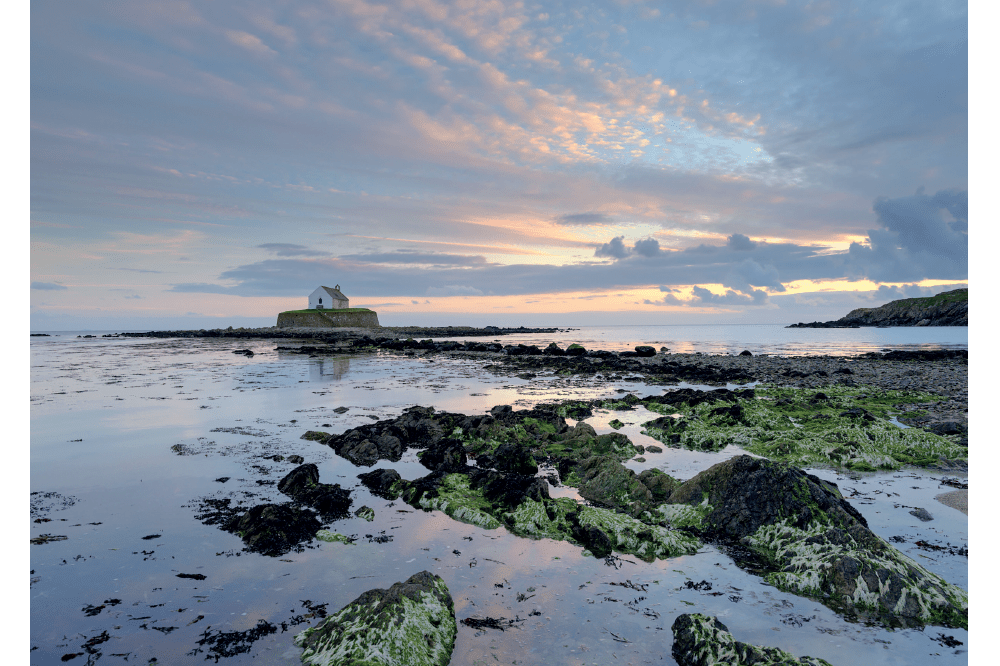My pilgrim companion William Parsons and I did not call our first journey a pilgrimage. Rather, it was a song walk: a walk with a purpose of taking a song, ‘The Hartlake Bridge Tragedy’, back to where it came from. It was also an attempt to reclaim my place in the world, after too much time spent in front of my computer. Stepping out and walking with intention.
It did the trick. When we arrived at the monument that commemorates those who had drowned, we were met by chance by a couple who had three ancestors who had died in the Medway tragedy but did not know the song. Thus we returned the song to its bloodline, not just its place. We also met scenes of beauty along the way, including the chapel at Tudeley, full of Marc Chagall’s stained glass masterpieces dedicated to the river’s victims.
In Pevensey’s porch I witnessed a storm filling the whole sky with lightning bolts
It wasn’t long before I felt the itch to make pilgrimage again. Within a few months, I was on the path from London to Walsingham, recording a folk or sacred song a day for two weeks. Getting out of London took a few days of walking – the urban centre stretches a long way. One highlight was a night sleeping in the Covert Way Local Nature Reserve in late spring, waking up to the loudest possible alarm clock: thousands of birds singing their dawn chorus.
Another was the Royston Cave, with its hundreds of mysterious chalk carvings underneath a busy road. Why were they there, and why did the place feel so powerful? Places like that seem to exist in order to make us aware of forces we don’t understand.
We slept by the forest-enclosed holy well at Santon Downham, just outside Thetford, awaking to the sight of Duke of Edinburgh walkers (complete with their huge backpacks), looking down at their maps and walking straight past us. As we got closer to Walsingham, the frequency of medieval churches increased, evidence of the once hugely popular pre-Reformation pilgrimage route, which is now largely unwalked. Walsingham Abbey was beautiful with its daffodils and spring flower abundance. Will and I sang the 16th-century ‘Wracks of Walsingham’ song in the crypt.
Our next pilgrimage was a winter one from Winchester to Canterbury, along the South Downs. When I co-founded the British Pilgrimage Trust in 2014, we made this our flagship route, the Old Way. We walked for just over three weeks, literally singing for our supper, spending no money of our own, either wild camping or accepting hospitality and food along the way. The old tradition of British hospitality is not dead. We also slept in churches and their porches. Firle Church, with its charismatic vicar Peter Owen Jones, was beautiful as the morning light streamed in through the window designed by John Piper.
In Pevensey’s porch I witnessed a storm filling the whole sky with lightning bolts. You don’t have these kinds of experiences sleeping under a roof with four walls. At Canterbury, Becket’s shrine of martyrdom has a depth of devotional power that makes you ask what you stand for; that single candle in the centre, marking where his bejewelled tomb once stood, speaks very deeply.
My next two pilgrimages were ‘source to sea’ quests along the Rivers Teifi and Towy starting in the Cambrian mountains in Wales. At Strata Florida Abbey, I learnt about the monks who pioneered a novel farming irrigation system. At the Teifi harp centre at Llandysul, I nosed around the last Welsh workshop to make concert harps by hand.
Another pilgrimage took us further north in Wales, to the holy isle of Anglesey, tracing the journey between Caernarfon, where the Romans set off to exterminate the last of the Druids in Britain, and Holyhead Mountain, the holiest place for Druids in western Europe at the time of the invasion around 60 ad. Here my companion Will and I composed a new song using a 3,000 year-old ancient Welsh lullaby, ‘Pais Dinogad’. The island of Llanddwyn and Porth Cwyfan made for dramatic sleeping spots, exposed to the elements and accompanied by remote holy wells, ruined chapels and a working church cut off by the tide. I also slept in a neolithic round barrow but ran out in the middle of the night, terrified by who knows what. I’d had a similar experience the year before in a prehistoric long barrow in Wiltshire.
A few years have passed since that flurry of making pilgrimage. Recently I took to the path again, along St Bega’s Way from St Bees to St Bega’s, Bassenthwaite, in the Lake District and back again, revisiting my childhood walking holidays and re-experiencing the land in a new, purposeful way. Here, the stone bothies and youth hostels for sleeping, the waterfalls, lakes and forest brooks for bathing, the sheep and remote holy places in the mountains, and the region’s abundance of wild water for drinking, made my soul sing.
Visit the British Pilgrimage Trust’s website britishpilgrimage.org to download routes and book accommodation in churches. Britain’s Pilgrim Places by Nick Mayhew-Smith and Guy Hayward contains several of the sites mentioned in this article.






Comments